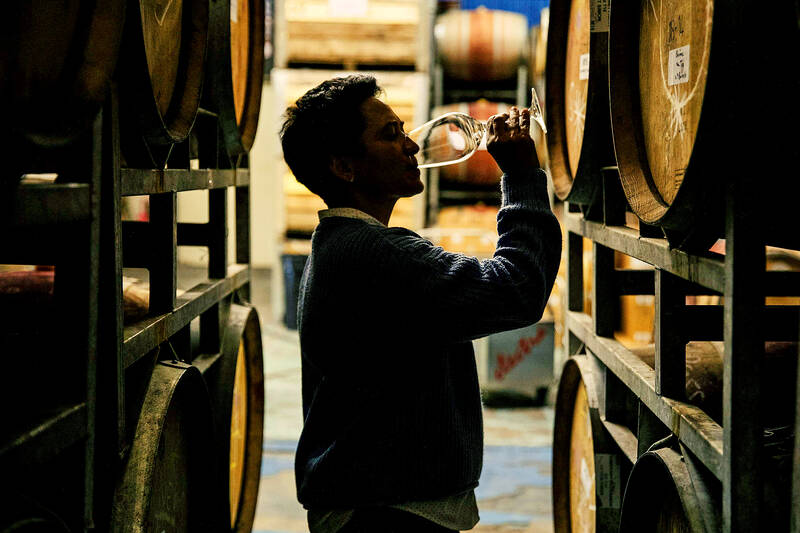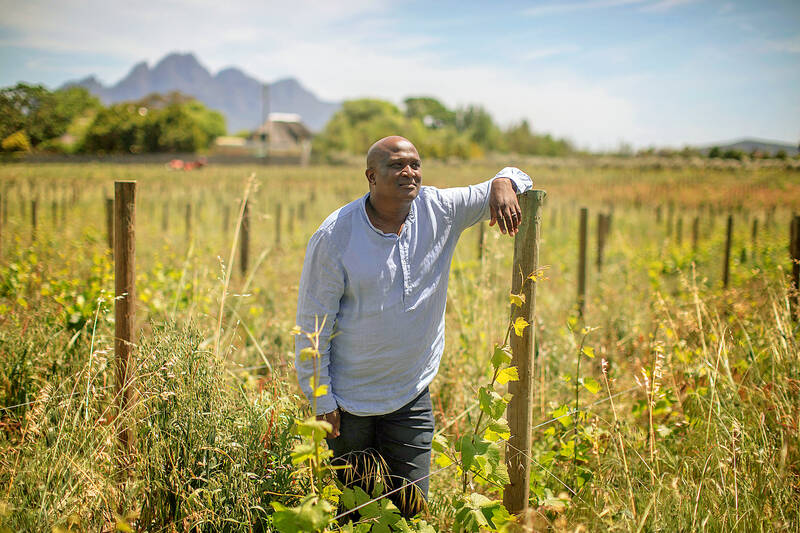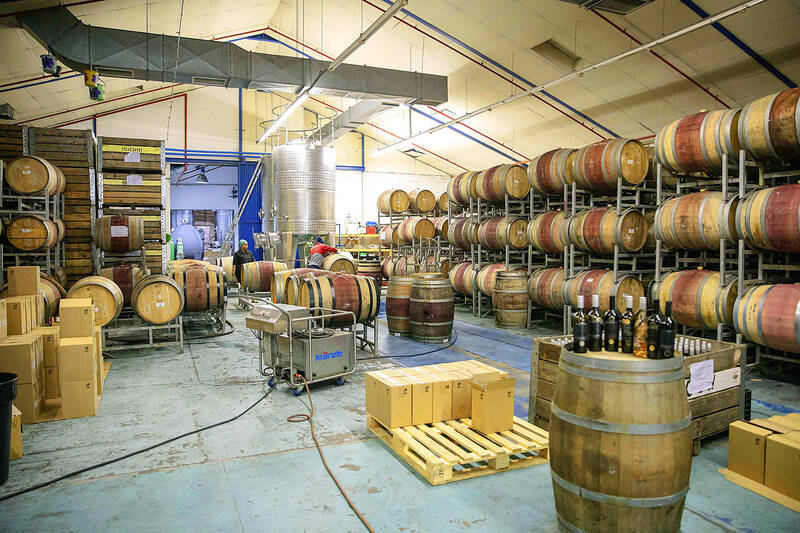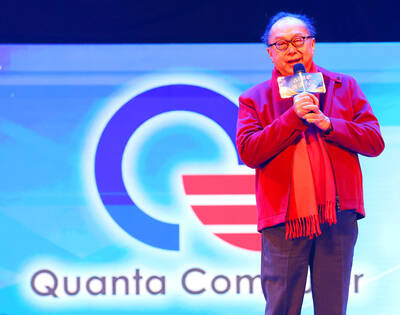Winemaking was a profession most South African parents could never have envisioned for their children, but black South Africans are today managing to break through multiple barriers into the renowned industry, transforming a landscape that was historically white.
Paul Siguqa, 41, bought Klein Goederust farm (Dutch for “a little good rest”) after saving up for 15 years.
His mother worked for 37 years at a farm in South Africa’s Cape winelands under the white minority apartheid regime.

Photo: AFP
Warning: Excessive consumption of alcohol can damage your health
“If you grow up on a farm as children of farm laborers — black farm laborers — you are raised to be the next crop of labor for that farmer,” Siguqa said.
He purchased the “rundown” farm in 2019, renovated it and opened last year.
“If we want to see change in an industry, we need to be the change,” he said, after inspecting his flowering grape crop at the farm in Franschhoek (French corner), a region dotted with centuries-old vineyards.

Photo: AFP
The rise of entrepreneurs of color has been slow and still faces serious obstacles, including a lack of access to land and capital. As a result, an industry push aims to accelerate the pace of change.
“Nobody’s getting nowhere slowly,” said Wendy Petersen, manager at SA Wine Industry Transformation Unit, which organizes grants and internships for start-ups.
Often the resources are not enough and have to be spread thinly among the candidates.

Photo: AFP
To help them grow, the organization has launched the Wine Arc tasting room in South Africa’s wine producing hub Stellenbosch, to promote budding producers.
Among the brands featured is Carmen Stevens Wines, which became South Africa’s first fully black-owned winery when it launched in 2011 and released its first vintage in 2014.
“The difficult part of winemaking is selling this product, is getting this product to somebody’s table and somebody coming back and saying: ‘I want more,’” Carmen Stevens said.
The 51-year-old is an unlikely winemaker, having grown up in the Cape Flats — an area marred by poverty and gangsters. Her mother, a factory worker, would buy her Mills & Boon fiction novels, many set in vineyards and involving wine.
South Africa was still under the racially segregated apartheid regime when Stevens made her first attempt to study winemaking in 1991. After being repeatedly refused, she was accepted at a college in 1993.
Her perseverance paid off. This year she took home three gold medals at a South African wine and spirits event for her sauvignon blanc and newly released rose named after her mother, Julie.
Like many black-owned brands, she procures her grapes from farmers in the region, not yet having her own land to cultivate.
Land access is “the biggest barrier for black people participating in the wine industry,” Siguqa said.
“That’s very political,” because historically the majority of black people, who make up about 80 percent of the population, do not have access to land, he said.
Black people “are competing, with old intergenerational, white rands,” as well as with foreign buyers that are purchasing prime land, he said.
“You are competing with the US dollars, with the pound and the euro,” he added.
The first vineyards were established in the 1600s by French Huguenots.
Since then, land has passed down through generations, and when sales do occur, it has often been to neighbors, leaving little opportunity for newcomers to enter the market, said Maryna Calow, communications manager at industry group Wines of South Africa.
For those non-white operators who have broken the barriers into the industry, it has been a bittersweet journey so far — having taken so long to achieve and, once in, the pressure to not fail.
“We’ve been free for 28 years and one would have wanted to see a lot more black people participating in the industry,” Siguqa said, with wine bottles lined up on a table next to him.
Originally established in 1905, his farm this month won an award in Cape Town for offering an authentic South African experience.
Out of the hundreds of winemakers in the country, Africa’s top wine producer, just more than 80 brands are black-owned, Petersen said.

Intel Corp chief executive officer Lip-Bu Tan (陳立武) is expected to meet with Taiwanese suppliers next month in conjunction with the opening of the Computex Taipei trade show, supply chain sources said on Monday. The visit, the first for Tan to Taiwan since assuming his new post last month, would be aimed at enhancing Intel’s ties with suppliers in Taiwan as he attempts to help turn around the struggling US chipmaker, the sources said. Tan is to hold a banquet to celebrate Intel’s 40-year presence in Taiwan before Computex opens on May 20 and invite dozens of Taiwanese suppliers to exchange views

Application-specific integrated circuit designer Faraday Technology Corp (智原) yesterday said that although revenue this quarter would decline 30 percent from last quarter, it retained its full-year forecast of revenue growth of 100 percent. The company attributed the quarterly drop to a slowdown in customers’ production of chips using Faraday’s advanced packaging technology. The company is still confident about its revenue growth this year, given its strong “design-win” — or the projects it won to help customers design their chips, Faraday president Steve Wang (王國雍) told an online earnings conference. “The design-win this year is better than we expected. We believe we will win

Quanta Computer Inc (廣達) chairman Barry Lam (林百里) is expected to share his views about the artificial intelligence (AI) industry’s prospects during his speech at the company’s 37th anniversary ceremony, as AI servers have become a new growth engine for the equipment manufacturing service provider. Lam’s speech is much anticipated, as Quanta has risen as one of the world’s major AI server suppliers. The company reported a 30 percent year-on-year growth in consolidated revenue to NT$1.41 trillion (US$43.35 billion) last year, thanks to fast-growing demand for servers, especially those with AI capabilities. The company told investors in November last year that

Power supply and electronic components maker Delta Electronics Inc (台達電) yesterday said it plans to ship its new 1 megawatt charging systems for electric trucks and buses in the first half of next year at the earliest. The new charging piles, which deliver up to 1 megawatt of charging power, are designed for heavy-duty electric vehicles, and support a maximum current of 1,500 amperes and output of 1,250 volts, Delta said in a news release. “If everything goes smoothly, we could begin shipping those new charging systems as early as in the first half of next year,” a company official said. The new